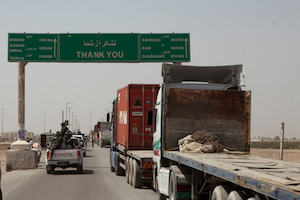Kadyrov and the Middle East: Threats to Russia's Strategy
Inal Sherip
April 3, 2025
Ramzan Kadyrov's transformation from a stalwart defender of Russia's policy of support for traditional Islam in the North Caucasus to an increasingly independent actor with divided loyalties represents a significant threat to Russia's regional security strategy. This shift, marked by his growing ties to Gulf monarchies and subtle adoption of the very religious practices he once opposed, signals a critical juncture in Russia's decades-long approach to managing Islamic influence in its southern territories.
Read Kadyrov and the Middle East: Threats to Russia's Strategy (PDF)
Afghanistan-Iran Trade Corridors to Bear Fruit for Both India and China
By Tristan Kenderdine
July 17, 2018, the CACI Analyst
A strategic deployment of trade corridors is taking shape across Afghanistan and Iran as both India and China subvert each other’s trade strategies through key geoeconomic states. Afghanistan’s land corridor to Chabahar port connects it to India by sea, creating a Persian-Gulf to Caspian Sea corridor, while the Afghan air corridor to India provides a parallel, more direct trade route. By contrast, China’s twin economic corridors in the region run perpendicular: north-south through Pakistan to the Gulf, and east-west through Iran to Istanbul. Pakistan’s Gwadar and Iran’s Chabahar are thus effectively in the same geopolitical node, connecting very different Great Game trade strategies.

Is there an Agreement on Caspian Sea Delimitation?
By Stephen Blank
January 25, 2018, the CACI Analyst
On December 5, 2017, Russian Foreign Minister Sergei Lavrov announced that all the key issues regarding the delimitation of the Caspian Sea had been resolved and that a treaty was being prepared for heads of state to sign in 2018 in Astana. Yet less optimistic statements from the other parties, particularly Iran, suggest that Lavrov’s assessment was premature. If Russia and Iran can nevertheless reconcile their differences on the demarcation of the Caspian, this would have important strategic consequences not only for the littoral states, but also for the Caucasus, Central Asia and the Middle East.

Russian intervention in Syria and the Caucasus
By Stephen Blank
November 27th, 2016, The CACI Analyst
Few people think about trends in the Caucasus with reference to or in the context of Russia’s Syrian intervention. But Moscow does not make this mistake. From the beginning, Moscow has highlighted its access to the Caucasus through overflight rights and deployment of its forces in regard to Syria, e.g. sending Kalibr cruise missiles from ships stationed in the Caspian Sea to bomb Syria. Therefore we should emulate Russia’s example and seriously assess military trends in the Caucasus in that Syrian context.
Revival of Islamist insurgency in the North Caucasus?
By Huseyn Aliyev
October 14th, 2016, The CACI Analyst
The last week of August 2016 saw two large-scale Counter-Terrorist Operations (CTOs) in the North Caucasus republics of Kabardino-Balkaria and Dagestan, followed by another CTO conducted in the second week of September. This relatively low-scale increase in military confrontations between militants and security forces in the region nonetheless indicates a steady recovery of non-ISIS Islamist cells, which have been in decline since the emergence of ISIS in the region. While these recent developments may not indicate a revival of the local Islamist insurgency, they indicate that local insurgent jama’ats are still present and active in the region.





